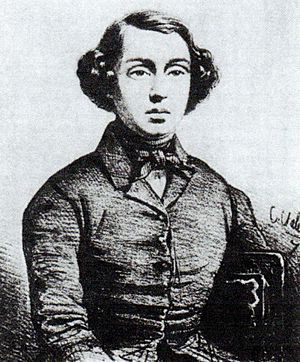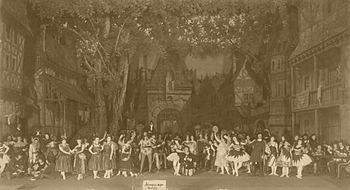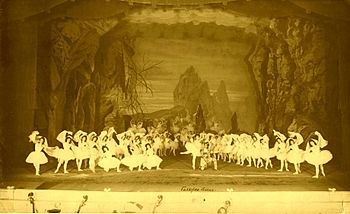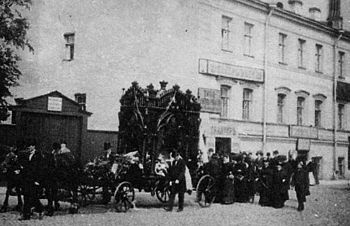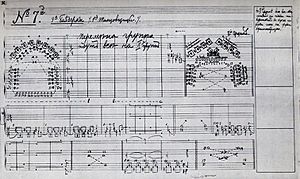Marius Petipa facts for kids
Quick facts for kids
Marius Petipa
|
|
|---|---|

Maestro Marius Ivanovich Petipa, premier maître de ballet of the St. Petersburg Imperial Theatres. St. Petersburg, 1887.
|
|
| Born |
Marius Alphonse Petipa
11 March 1818 |
| Died | 14 July 1910 (aged 92) Gurzuf, Taurida Governorate, Russian Empire
|
| Nationality | French-Russian |
| Education | Brussels Conservatory Grand Théâtre de Bordeaux |
| Known for | Ballet, choreography |
Marius Ivanovich Petipa (Russian: Мариус Иванович Петипа), born Victor Marius Alphonse Petipa (March 11, 1818 – July 14, 1910), was a famous French ballet dancer, teacher, and choreographer. He is known as one of the most important ballet masters and choreographers in the history of ballet.
Marius Petipa had a very long career as the Premier maître de ballet (First Ballet Master) of the St. Petersburg Imperial Theatres. This meant he was the main Ballet Master and choreographer for the Imperial Ballet (now called the Mariinsky Ballet). He held this important job from 1871 to 1903. Petipa created more than fifty ballets. Many of these ballets are still performed today, either in their original form or in new versions inspired by his work.
Some of his most famous ballets include:
- The Pharaoh's Daughter (1862)
- Don Quixote (1869)
- La Bayadère (1877)
- The Sleeping Beauty (1890)
- The Nutcracker (which he choreographed with Lev Ivanov) (1892)
- Raymonda (1898)
Petipa also brought back many ballets that other choreographers had created. He often made these ballets even better, and his versions became the standard ones that everyone else would follow. Some of his most famous revivals were Le Corsaire, Giselle, La Esmeralda, Coppélia, and Swan Lake (with Lev Ivanov).
Many parts of Petipa's ballets, even from those that are no longer performed in full, have survived as independent pieces. These include the Grand Pas classique from Paquita and the Don Quixote Pas de deux. All of his full-length ballets and individual pieces that are still performed today are considered very important parts of ballet history.
Contents
Early Life and Ballet Training
Marius Petipa was born in Marseilles, France, on March 11, 1818. His mother, Victorine Grasseau, was an actress and drama teacher. His father, Jean-Antoine Petipa, was a well-known Ballet Master and teacher in Europe. When Marius was born, his father was a principal male dancer in Marseille. In 1819, his father became the Ballet Master for that theater.
Marius Petipa spent his early childhood traveling around Europe with his family. His parents moved often for their work. When Marius was six, his family settled in Brussels. His father became the Ballet Master and principal dancer at the Théâtre de la Monnaie. Marius went to school in Brussels and also studied music at the Brussels Conservatory, where he learned to play the violin.
When Marius was seven, his father started teaching him ballet. At first, Marius didn't like dancing much. But soon, he grew to love this art form that was so important to his family. He quickly became very good at it. At age nine, Marius performed for the first time in a ballet. He played a Savoyard in his father's show of La Dansomanie in 1827.
In 1830, the Belgian Revolution started in Brussels. The fighting caused all theaters to close, and Jean Petipa lost his job. The Petipa family faced hard times for several years.
In 1834, the family moved to Bordeaux, France. Marius's father found a job as the Ballet Master at the Grand Théâtre de Bordeaux. In Bordeaux, Marius finished his ballet training with the famous teacher Auguste Vestris. By 1838, Marius became a principal dancer for the Ballet de Nantes in France. While in Nantes, young Petipa started trying to create his own short ballets and dances.
In 1839, Marius Petipa, then 21, went on a tour of the United States with his father and other French dancers. They performed in New York City, which was the first time ballet was seen there. However, the tour was not successful. Many American audiences at that time had never seen ballet before. Also, the person who arranged the tour stole most of their money and disappeared. When Petipa left for France, his ticket was only for Nantes. But he secretly traveled to Paris instead.
By 1840, Petipa performed with the ballet company of the Comédie Française in Paris. He danced with the famous ballerina Carlotta Grisi. He also performed at the Paris Opéra, where his brother Lucien Petipa was a principal dancer.
Dancing and Choreographing in France and Spain
In 1841, Petipa became a principal dancer at the Grand Théâtre in Bordeaux. He continued to study with Vestris and danced leading roles in ballets like La Fille Mal Gardée and Giselle. He was praised for his dancing and his ability to partner ballerinas. While in Bordeaux, Petipa began creating his own full-length ballets, such as La Jolie Bordelaise and La Vendange.
In 1843, Petipa moved to Madrid, Spain, to be a principal dancer at the Teatro Real. For the next three years, he learned a lot about traditional Spanish Dancing. He also created new ballets based on Spanish themes, like Carmen et son toréro. In 1846, he had a personal issue that caused him to leave Spain quickly and return to Paris.
Moving to St. Petersburg, Russia
In 1847, Petipa's family decided it was best for him to leave France. His brother, Lucien Petipa, knew people in Russia and helped Marius get an invitation to St. Petersburg. The Imperial Theaters needed a strong male dancer for their main ballerina, Yelena Andreyanova. So, Marius Petipa arrived in St. Petersburg late in 1847. This was the start of his amazing career as one of the most important choreographers ever.
Early Years in Russia
In 1847, Petipa became a principal dancer at the Imperial Theatres in St. Petersburg, which was then the capital of Russia. He arrived on June 5, 1847. In 1848, his father also moved to St. Petersburg and taught at the Imperial Ballet School.
For his first show, Petipa helped stage the ballet Paquita, which premiered in St. Petersburg on October 8, 1847. He danced a main role, and Yelena Andreyanova was the lead ballerina. The next year, Petipa and his father staged Le Diable amoureux, known as Satanella.
When Petipa arrived, the Imperial Ballet was not as popular as it once was. But the new productions of Paquita and Satanella helped the company become famous again. A critic wrote that the ballet company was "reborn" and returned to its "former level of glory."
In 1849, the famous French Ballet Master Jules Perrot came to St. Petersburg and became the main Ballet Master. He brought with him the talented composer Cesare Pugni. Petipa danced in many of Perrot's ballets and helped him stage revivals like Giselle (1850) and Le Corsaire (1858). Petipa learned a lot from Perrot, who was the most celebrated choreographer in Europe at the time. Even though Petipa didn't create many original ballets during this period, he did choreograph dances for many operas.
In 1854, Petipa married the ballerina Mariia Surovshchikova-Petipa. They had two children: Marie Mariusovna Petipa (who became a famous dancer) and Jean Mariusovich Petipa.
On January 21, 1855, Petipa presented his first original ballet in six years, called L’Étoile de Grenade (The Star of Granada). He worked with composer Cesare Pugni for the first time on this ballet. Petipa created several more ballets during this time, all made for his wife Maria, who was now the main ballerina of the Imperial Theatres.
In 1858, Jules Perrot retired and went back to France. Petipa hoped to take his place as the main Ballet Master. He was 41 and thinking about retiring from dancing. However, in 1860, another famous French Ballet Master, Arthur Saint-Léon, was given the job. This started a friendly competition between Petipa and Saint-Léon, which helped the Imperial Ballet reach new heights in the 1860s.
Becoming Second Ballet Master
In 1861, the famous Italian ballerina Carolina Rosati was about to leave Russia. Her contract said she should have a special performance in a new ballet. The theater director, Saburov, at first said no, because there wasn't enough money or time. Rosati asked Petipa for help. Petipa reminded Saburov about the contract. Saburov then asked Petipa if he could create a new full-length ballet in just six weeks. Petipa confidently said, "Yes, I shall try, and probably succeed."
Petipa had a story for a ballet called La Fille du Pharaon (The Pharaoh's Daughter). This story was inspired by a book about ancient Egypt. People in Europe were very interested in ancient Egypt at that time, so Petipa was sure this ballet would be a big hit.
Petipa worked with composer Pugni, who wrote the music while Petipa was rehearsing. The Pharaoh's Daughter premiered on January 30, 1862, and was a huge success. It was so grand and exotic that it became the most popular ballet at the Imperial Theatres. By 1903, it had been performed 203 times! Because of this great success, Petipa was given the job of second Ballet Master.
Arthur Saint-Léon, the main Ballet Master, responded to Petipa's success with his own fantastic ballet, Le Petit Cheval bossu. This ballet was also very popular, with amazing scenes underwater and on a magical island.
Even though Saint-Léon was technically Petipa's boss, people saw them as equals. They competed with each other by creating wonderful ballets throughout the 1860s. Both had their own fans and ballerinas. Petipa often created roles for his wife, Mariia Surovshchikova-Petipa, while Saint-Léon worked with Marfa Muravieva. Most of their ballets during this time had music by Cesare Pugni.
On October 31, 1868, Petipa presented a huge ballet called Le Roi Candaule (Tsar Candavl). It was made for the visiting ballerina Henrietta D'or. This ballet had a famous dance called the Pas de Vénus, which was considered one of Petipa's greatest classical dances. Le Roi Candaule broke attendance records and was performed 194 times by 1903.
Petipa's last work of the 1860s is still a very important ballet today: Don Quixote. It was created for Moscow's Bolshoi Theatre. The composer Ludwig Minkus wrote the music, starting a long and successful partnership between him and Petipa.
Becoming Principal Ballet Master
In 1869, Saint-Léon's contract ended, and it was not renewed. He died shortly after in 1870. The composer Cesare Pugni, who worked with Petipa for many years, also died in 1870.
Petipa was officially named premier maître de ballet (principal Ballet Master) on March 12, 1871. On November 21, 1871, Petipa presented an expanded and even grander version of Don Quixote in St. Petersburg. Ludwig Minkus's music for this ballet was highly praised, and he became the official Ballet Composer for the Imperial Theatres. Petipa and Minkus created many successful new ballets and revivals throughout the 1870s, including La Camargo (1872) and La Bayadère (1877).
In 1877, Petipa staged his greatest work so far, the exotic La Bayadère, with music by Minkus. It premiered on February 4, 1877. This ballet included Petipa's famous scene called The Kingdom of the Shades, which has some of his most amazing choreography. La Bayadère became one of Petipa's most lasting works. Even today, The Kingdom of the Shades is a huge challenge for classical ballet dancers.
Petipa and his wife, Mariia Surovshchikova-Petipa, separated in 1875. She died in 1882 from smallpox. In 1876, Petipa married the ballerina Lyubov Savitskaya. They had six children together. With so many children and grandchildren, Petipa had a large family. He was known for being generous, often buying gifts for his family and treats for dancers during rehearsals.
Throughout the 1880s, Petipa often staged revivals of older ballets. In 1881, he revived Paquita and added the famous Paquita Grand pas classique, which is still performed by ballet companies worldwide. In 1884, he staged his best version of Giselle, and in 1885, he created a new production of Coppélia that became the basis for almost all later versions. Petipa also created new ballets like Nuit et Jour (Night and Day) in 1883, which was made for the coronation of Tsar Alexander III.
In late 1885, the great Italian ballerina Virginia Zucchi began dancing with the St. Petersburg Imperial Ballet. Petipa staged a revival of La Esmeralda especially for her in 1886. For this show, he added the famous La Esmeralda pas de six, which allowed Zucchi to show off her amazing dramatic skills.
By 1885, Petipa, who was 67, started to suffer from a severe skin condition called eczema. The pain often kept him from working for long periods.
In 1881, Ivan Vsevolozhsky became the director of the St. Petersburg Imperial Theatres. In 1885, the main theater building was found to be unsafe. So, the ballet and opera companies moved to the Imperial Mariinsky Theatre. To celebrate this move, a grand performance was held in February 1886, including Petipa's ballet The Magic Pills.
The Golden Age of Russian Ballet
During the late 1800s and early 1900s, ballet in St. Petersburg was at its peak. The Russian Emperor, who was very wealthy, spent millions of rubles each year on the Imperial Ballet, opera, and the Imperial Ballet School (now the Vaganova Academy of Russian Ballet). Every new season, Petipa had to create a new multi-act ballet, choreograph dances for operas, and prepare special performances for the royal family. This period is known as the golden age of Russian ballet.
An important change happened when Ludwig Minkus retired in 1886. The director, Ivan Vsevolozhsky, decided to stop having an official "Ballet Composer." This allowed for more variety in the music used for new ballets.
Petipa presented his huge ballet La Vestale in 1888. The next year, Vsevolozhsky asked the Italian conductor Riccardo Drigo to compose the music for Petipa's Le Talisman. Drigo's music was highly praised.
Director Vsevolozhsky then asked the great composer Pyotr Ilyich Tchaikovsky to write the music for Petipa's The Sleeping Beauty. It premiered on January 15, 1890. This ballet became one of Petipa's masterpieces. The Sleeping Beauty was so popular that by April 1903, it had been performed 100 times, making it one of the most popular ballets in the Imperial Ballet's collection.
In 1892, Petipa was diagnosed with a severe skin disease called pemphigus. The constant pain kept him from choreographing for most of the 1892–1893 season. Because of this, the responsibility for staging Tchaikovsky's second ballet, The Nutcracker, fell to the second Ballet Master, Lev Ivanov. The Nutcracker premiered on December 18, 1892. Some critics at the time felt it wasn't a true ballet, focusing too much on spectacle.
Petipa's illness kept him from working for almost the entire 1892-1893 season. During this time, Enrico Cecchetti, a great Italian dancer and teacher, helped Lev Ivanov fill in for Petipa. In 1893, Petipa supervised Cecchetti and Ivanov's staging of Cinderella. The Italian ballerina Pierina Legnani made her debut in the main role. On opening night, December 15, 1893, her perfect technique amazed everyone. She performed 32 fouettés en tournant, a feat never seen before. Petipa was so impressed that he gave her the rare title of Prima ballerina assoluta. Over the next eight years, Petipa created many new ballets especially for her.
Petipa returned to choreography with the one-act ballet Le Réveil de Flore (The Awakening of Flora), with music by Riccardo Drigo. It premiered on August 9, 1894, at Peterhof Palace for the wedding of Tsar Alexander III's daughter.
In 1893, Tchaikovsky died. In February 1894, a special performance was held in his honor. For this event, Lev Ivanov staged the second act from Tchaikovsky's Swan Lake. This part of Swan Lake was a huge success. It was then decided to stage a full revival of Swan Lake for the 1894–1895 season. Ivanov staged the second and fourth acts, and Petipa staged the first and third acts. Riccardo Drigo updated Tchaikovsky's music. The premiere on January 27, 1895, with Legnani as both Odette and Odile, was a triumph. Petipa and Ivanov's version of Swan Lake became one of the greatest ballets of all time, and it remains a true test for classical ballerinas and the corps de ballet (group dancers).
The Turn of the 20th Century
In his final years, Petipa spent a lot of time reviving older ballets. In 1895, he presented grand revivals of his 1889 Le Talisman and Saint-Léon's 1864 The Little Humpbacked Horse, both starring Legnani. Around 1900, Petipa brought back more ballets: The Pharaoh's Daughter (1898), La Esmeralda, Giselle, Le Corsaire (all in 1899), La Bayadère (1900), and Le Roi Candaule (1903). These revivals were Petipa's final touches on these important works.
Petipa also created new ballets. For the celebration of Emperor Nicholas II's coronation in Moscow, Petipa presented the one-act ballet Le Perle in 1896, which was a great success. This ballet was a grand spectacle with a cast of 200 dancers.
In 1896, Petipa had a special performance to celebrate 50 years of working for the St. Petersburg Imperial Theatres. For this, he created one of his most lavish ballets: Bluebeard, based on the fairytale. It premiered on December 20, 1896. Many critics felt it was mostly a huge show of spectacle and dances, but they all praised the 78-year-old Petipa's amazing imagination in creating classical dances.
On January 19, 1898, the nearly 80-year-old Petipa presented one of his greatest ballets, Raymonda, with music by Alexander Glazunov. It was a great success. The Pas classique hongrois from the last act became one of his most famous and lasting pieces.
Petipa presented what would be his final masterpiece on February 23, 1900, at the Hermitage Theatre. This was Les Millions d'Arlequin (or Harlequinade), a ballet with music by Drigo. Harlequinade was dedicated to the new Empress, Alexandra Feodorovna.
Final Years with the Imperial Ballet
Despite his many achievements, Petipa's last years with the Imperial Ballet were hard. Around 1900, new ideas in classical dance began to appear. Petipa also had a difficult relationship with the new director of the Imperial Theatres, Vladimir Telyakovsky, who started in 1901. Telyakovsky didn't like Petipa's work, feeling that classical ballet had become boring under him. He thought other choreographers should have a chance. But even at 83, and suffering from his skin disease, Petipa showed no signs of slowing down, which annoyed Telyakovsky.
In 1902, Telyakovsky invited Alexander Gorsky, a former dancer, to stage his own version of Petipa's 1869 ballet Don Quixote. Gorsky had created a very different version in Moscow. Petipa was furious when he heard this new version would be staged in St. Petersburg, especially since he hadn't been asked about it. While watching a rehearsal of Gorsky's production, Petipa was heard shouting, "Will someone tell that young man that I am not yet dead?!"
In late 1902, Petipa began working on a ballet based on "Snow White and the Seven Dwarfs" called The Magic Mirror. This ballet was for his own special performance, marking a "semi-retirement." The ballet premiered on February 22, 1903. It had strange sets and costumes that many thought were not right for a classical ballet. Even so, Petipa received a huge cheer from the audience. The Magic Mirror was not considered a success, but Petipa's choreography was not criticized. Soon, rumors spread that Petipa would be replaced.
Telyakovsky knew he couldn't legally fire Petipa, who was still under contract. So, he tried to force the old Ballet Master out. In 1902, Telyakovsky created a committee to take away Petipa's power over casting and choosing ballets. However, the committee members made Petipa the chairman! Telyakovsky then started to purposely not send carriages for Petipa or not tell him about rehearsals. But Petipa's old age and poor health left him with little energy to fight the director.
Despite the situation with Telyakovsky and his health, Petipa still worked. Dancers often asked him for advice and coaching. In 1904, Petipa coached the great Anna Pavlova for her performances in Giselle and Paquita.
Petipa's diaries show his constant fear of his aging body and that he didn't have much time left. He spent almost every minute creating new dances and fixing older ones. In 1903, he created completely new choreography for parts of his 1868 ballet Le Roi Candaule. This work made him write in his diary, "I am amazing."
Petipa then started what would be his final ballet, La Romance d'un Bouton de rose et d'un Papillon with music by Drigo. It was scheduled to premiere on February 5, 1904, but Telyakovsky suddenly canceled the performance, saying it was because of the Russo-Japanese War. This was the final blow for Petipa. After this, he was rarely seen at the theater. The minister of the Imperial Court gave Petipa the title "Ballet Master for life" and a yearly pension.
Later Years and Death
Petipa made his final ballet composition on January 17, 1905. He wrote in his diaries next to this entry, "...it's finished!"
Petipa stayed in St. Petersburg until 1907. His doctors suggested he move to Yalta in southern Russia for his health. The Petipa family then moved to the resort of Gurzuf in the Crimea, where he spent his remaining years. In 1907, Petipa wrote in his diary, "I can state that I created a ballet company of which everyone said: St. Petersburg has the greatest ballet in all Europe." Petipa died on July 14, 1910, at the age of 92. He was buried three days later in the Alexander Nevsky Monastery in St. Petersburg.
Recording His Works
Starting in 1891, many of Petipa's ballets and dances were written down using a special method called dance notation created by Vladimir Stepanov.
After the Russian Revolution of 1917, the Imperial Ballet's manager, Nicholas Sergeyev, left Russia with these notations. In the 1930s, Sergeyev used these notes to stage Petipa's The Sleeping Beauty, his version of Giselle, Coppélia, and The Nutcracker for the Vic-Wells Ballet in London (later the Royal Ballet). This helped keep Petipa's amazing choreography alive for future generations.
Ballets by Marius Petipa
Here are some of the ballets Marius Petipa created or helped stage:
In France
- Le Droit du seigneur (1838)
- La Petite Bohémienne (1838)
- La Jolie Bordelaise (1840)
- La Vendange (1842)
In Spain
- Carmen et son toréro (1845)
- La Perle de Séville (1845)
In Russia
- Paquita (revival, 1847)
- Satanella (revival, 1848)
- Giselle (revival, 1850)
- Le Corsaire (revival, 1858)
- The Pharaoh's Daughter (1862)
- Le Roi Candaule (1868)
- Don Quixote (1869)
- La Camargo (1872)
- La Bayadère (1877)
- The Sleeping Beauty (1890)
- The Nutcracker (with Lev Ivanov, 1892)
- Cinderella (supervised, 1893)
- Swan Lake (with Lev Ivanov, 1895)
- La Halte de la cavalerie (1896)
- Bluebeard (1896)
- Raymonda (1898)
- Les Millions d'Arlequin (1900)
- The Magic Mirror (1903)
Cultural Depictions
- Anna Pavlova, a film from 1983, where Marius Petipa was played by Pyotr Gusev.
See also
 In Spanish: Marius Petipa para niños
In Spanish: Marius Petipa para niños


